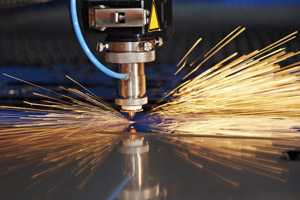Elements of successful connections

Understanding laser processes better can advance additive manufacturing techniques used to print three-dimensional objects. © kadmy/iStock/Thinkstock
High-power lasers that can selectively cut and join metallic products are becoming increasingly important in today’s manufacturing industry. Now, Yingchun Guan from the A*STAR Singapore Institute of Manufacturing Technology and her co-workers have developed a technique that reveals exactly how molten elements vaporize and move about inside a laser-generated surface ‘plume’1 — findings that can advance additive manufacturing techniques used to print three-dimensional (3D) objects.
Researchers investigating the feasibility of 3D-printed implant materials often turn to magnesium–aluminum (Mg–Al) alloys because they are lightweight, tough and biocompatible. Recently, the A*STAR team demonstrated that laser surface melting of these alloys enhances their corrosion resistance as a result of a notable enhancement in the surface concentration of aluminum. It is difficult, however, to make the link between the initial alloy composition and the final product after laser processing, as many complex interactions occur in the cloud-like plume of laser-generated vapor particles.
Guan and her team designed a new experimental setup that can quantify which molten alloy elements are ejected into the laser plume. They positioned a thin silicon substrate perpendicular to a Mg–Al-based alloy a few millimeters from the laser firing point. Laser pulses then generated a plume that deposited onto the silicon surface.
When the researchers used a scanning electron microscope (SEM) to examine the deposits, they saw clear evidence of a phase explosion — a mixture of liquid and vaporized particles thrown out by the laser impact. These liquid deposits rendered many sections of the silicon wafer unsuitable for quantitative analysis.
But by combining the element-identifying capability of the SEM with time-of-flight mass spectrometry, the team produced ‘mass-resolved images’ that reconstructed the distribution of gaseous secondary ions in the plume.
The mass-resolved images revealed that Mg ions were evenly dispersed at high concentrations inside the plume. In contrast, the population of Al ions rises in the middle of the near-field region close to the laser firing point. Analysis showed that the Al species in the plume ‘fly’ further than those of Mg because of their higher transport rates in the hot near-field region.
Guan notes that the site-specific analytical capabilities of this technique should give researchers finer control over selective surface vaporization of alloying elements for enhanced, high-tech applications. “Our chemical analysis of the transport rates and distribution of vaporized species in the plume offers improved understanding of critical laser processes, including those used in additive manufacturing,” she says.
The A*STAR-affiliated researchers contributing to this research are from the Singapore Institute of Manufacturing Technology and the Institute of Materials Research and Engineering
- Guan, Y., Zhou, W., Zheng, H., Li, Z., Seng, H. L. & Hong, M. Analysis of selective vaporization behavior in laser melting of magnesium alloy by plume deposition. Laser and Particle Beams 32, 49–54 (2014). | article
Media Contact
All latest news from the category: Process Engineering
This special field revolves around processes for modifying material properties (milling, cooling), composition (filtration, distillation) and type (oxidation, hydration).
Valuable information is available on a broad range of technologies including material separation, laser processes, measuring techniques and robot engineering in addition to testing methods and coating and materials analysis processes.
Newest articles

NASA: Mystery of life’s handedness deepens
The mystery of why life uses molecules with specific orientations has deepened with a NASA-funded discovery that RNA — a key molecule thought to have potentially held the instructions for…

What are the effects of historic lithium mining on water quality?
Study reveals low levels of common contaminants but high levels of other elements in waters associated with an abandoned lithium mine. Lithium ore and mining waste from a historic lithium…

Quantum-inspired design boosts efficiency of heat-to-electricity conversion
Rice engineers take unconventional route to improving thermophotovoltaic systems. Researchers at Rice University have found a new way to improve a key element of thermophotovoltaic (TPV) systems, which convert heat…



